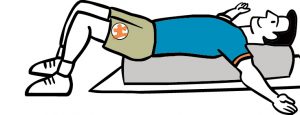Many individuals with autism have heightened sensory systems. If you try to teach exercise while their body is in this state, you may experience resistance from the child or student, you could become frustrated, and even worse, exercise may be seen as negative experience for your child or student.
To better prepare them to exercise begin with the exercises below, Log Stretch and Stability Ball Hug. These can help calm their bodies and minds, while even improving their posture and abdominal strength. And by using the Foam Roller and Stability Ball you are introducing them to fitness equipment that can become part of more advanced exercises as they progress.
 Stability Ball Hug
Stability Ball Hug
Objective: Help to relieve stress and calm the nervous system.
How To
- Have child kneel on the ground and place the stability ball at their knees. Next, have child lay their stomach on the ball and gently hug the ball. Make sure that their feet stay in contact with the ground so they keep their balance.
How Many
- Perform one to four sets for 20–60 seconds
- If your child requires more time, allow it, as long as they are not trying to get out of exercising or their specific activity.
Coaching Tips
- This can be paired with other exercises within a program.
- They may want to lie on their back, which is OK, but be aware of their surroundings and ensure that they are safe.
Champion Rachel compares this to lying on a Stability Ball to lying on Squeeze Machine. While it may not elicit the exact benefits, it can be a great and cost-effective alternative.
 Log Exercises
Log Exercises
Objective: To help improve the individual’s proprioception while increasing the flexibility and range of motion of the shoulder girdle.
How To
- It is important that you model how to get onto the log. When the child squats down to sit on the log you may have to adjust the log during the process. It is important that the butt is on the far end of the log and that the child then lies back. The back of the head should be on the log and in a neutral position and the neck should be relaxed.
How Many
- Begin with 30 seconds for the general stretch. If they want to stay on longer, that’s fine as they are in a safe position.
- When performing the arm actions, have them do 8–12 reps.
Coaching Tips
- Palms should face up.
- If the hands are not on the ground, that is OK. Don’t force them down, as this means that the muscles of the neck and shoulder girdle are tight. This will happen naturally, keep practicing and watch to see the improvement.
- Make sure the neck is not arched back. Chin should be down. You may have to prompt to get the neck into a neutral position.
Log Exercises can be like self-massages helping to reduce stress and tension in the neck. This is very important for our children but can also benefit mom and dad. So make sure you try this exercise!
Reprinted with permission from David Geslak.
Coach Dave, founder of Exercise Connection and ExerciseBuddy, is widely recognized for the pioneering of visual exercise programs for those with autism, as well as, his insightful and dynamic presentations. Nine universities have now adopted ExerciseBuddy, an App that inspires those with autism to exercise. As an author, former para-educator and Fitness Coordinator at a school for those with autism, the autism community has embraced Dave’s message and are especially encouraged by his results.
